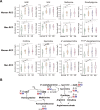Sex Differences in Colon Cancer Metabolism Reveal A Novel Subphenotype
- PMID: 32184446
- PMCID: PMC7078199
- DOI: 10.1038/s41598-020-61851-0
Sex Differences in Colon Cancer Metabolism Reveal A Novel Subphenotype
Abstract
Women have a lower incidence of colorectal cancer (CRC) than men, however, they have a higher incidence of right-sided colon cancer (RCC). This is of concern as patients with RCC have the poorest clinical outcomes among all CRC patients. Aberrant metabolism is a known hallmark and therapeutic target for cancer. We propose that metabolic subphenotypes exist between CRCs due to intertumoral molecular and genomic variation, and differences in environmental milieu of the colon which vary between the sexes. Metabolomics analysis of patient colon tumors (n = 197) and normal tissues (n = 39) revealed sex-specific metabolic subphenotypes dependent on anatomic location. Tumors from women with RCC were nutrient-deplete, showing enhanced energy production to fuel asparagine synthesis and amino acid uptake. The clinical importance of our findings were further investigated in an independent data set from The Cancer Genomic Atlas, and demonstrated that high asparagine synthetase (ASNS) expression correlated with poorer survival for women. This is the first study to show a unique, nutrient-deplete metabolic subphenotype in women with RCC, with implications for tumor progression and outcomes in CRC patients.
Conflict of interest statement
The authors declare no competing interests.
Figures







Similar articles
-
Plasma metabolomic profiling distinguishes right-sided from left-sided colon cancer.Clin Chim Acta. 2018 Dec;487:357-362. doi: 10.1016/j.cca.2018.10.010. Epub 2018 Oct 5. Clin Chim Acta. 2018. PMID: 30296444
-
Molecular Pathway Analysis Indicates a Distinct Metabolic Phenotype in Women With Right-Sided Colon Cancer.Transl Oncol. 2020 Jan;13(1):42-56. doi: 10.1016/j.tranon.2019.09.004. Epub 2019 Nov 21. Transl Oncol. 2020. PMID: 31760268 Free PMC article.
-
Sidedness Matters: Surrogate Biomarkers Prognosticate Colorectal Cancer upon Anatomic Location.Oncologist. 2019 Aug;24(8):e696-e701. doi: 10.1634/theoncologist.2018-0351. Epub 2019 Feb 12. Oncologist. 2019. PMID: 30755502 Free PMC article.
-
Different treatment strategies and molecular features between right-sided and left-sided colon cancers.World J Gastroenterol. 2015 Jun 7;21(21):6470-8. doi: 10.3748/wjg.v21.i21.6470. World J Gastroenterol. 2015. PMID: 26074686 Free PMC article. Review.
-
Differences in clinical features and oncologic outcomes between metastatic right and left colon cancer.J BUON. 2018 Dec;23(7):11-18. J BUON. 2018. PMID: 30722106 Review.
Cited by
-
Crosstalk of angiogenesis-related subtypes, establishment of a prognostic signature and immune infiltration characteristics in colorectal adenocarcinoma.Front Immunol. 2022 Nov 24;13:1049485. doi: 10.3389/fimmu.2022.1049485. eCollection 2022. Front Immunol. 2022. PMID: 36505481 Free PMC article.
-
Pure Ion Chromatograms Combined with Advanced Machine Learning Methods Improve Accuracy of Discriminant Models in LC-MS-Based Untargeted Metabolomics.Molecules. 2021 May 5;26(9):2715. doi: 10.3390/molecules26092715. Molecules. 2021. PMID: 34063107 Free PMC article.
-
UmetaFlow: an untargeted metabolomics workflow for high-throughput data processing and analysis.J Cheminform. 2023 May 12;15(1):52. doi: 10.1186/s13321-023-00724-w. J Cheminform. 2023. PMID: 37173725 Free PMC article.
-
AMIGO2 characterizes cancer-associated fibroblasts in metastatic colon cancer and induces the release of paracrine active tumorigenic secretomes.J Pathol. 2025 Jan;265(1):14-25. doi: 10.1002/path.6363. Epub 2024 Nov 11. J Pathol. 2025. PMID: 39523830 Free PMC article.
-
Discovery of decreased ferroptosis in male colorectal cancer patients with KRAS mutations.bioRxiv [Preprint]. 2023 Mar 1:2023.02.28.530478. doi: 10.1101/2023.02.28.530478. bioRxiv. 2023. Update in: Redox Biol. 2023 Jun;62:102699. doi: 10.1016/j.redox.2023.102699. PMID: 36909561 Free PMC article. Updated. Preprint.
References
-
- Colorectal Cancer Statistics, https://www.cdc.gov/cancer/colorectal/statistics/index.htm (2019).
-
- Venook AP. Right-sided vs left-sided colorectal cancer. Clin. Adv. Hematol. Oncol. 2017;15:22–24. - PubMed
Publication types
MeSH terms
Substances
Grants and funding
LinkOut - more resources
Full Text Sources
Molecular Biology Databases

